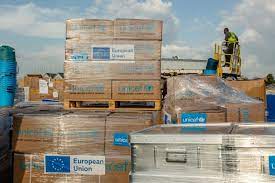EU activates new humanitarian air bridge to Goma, Democratic Republic of the Congo

Brussels: The EU has launched a new Humanitarian Air Bridge operation for the eastern Democratic Republic of the Congo (DRC), transporting essential supplies to the city of Goma.
They will be used to scale-up the humanitarian response in the eastern part of the country, where the already dire situation keeps deteriorating.
To mitigate this situation, the EU is organising two flights from Europe, carrying a total of over 180 tonnes of materials, including health and nutrition supplies. The humanitarian air bridge consists of 2 flights from Europe to Nairobi, from where the supplies are transported to Goma.
The first flight to Goma departed from Nairobi today, with a total of 8 such flights scheduled to take place until the end of August 2023.
Commissioner for Crisis Management, Janez Lenarčič, said: “The EU remains fully committed to assisting the most vulnerable in the Democratic Republic of the Congo. Heeding the UN’s call for a system-wide scale-up across the country, we are launching a humanitarian air bridge transporting essential supplies to Goma, in the eastern part of the Democratic Republic of the Congo. Combined with the additional humanitarian aid funding announced earlier in the year – bringing our total humanitarian aid funding to EUR 80 million for 2023 – our humanitarian air bridge will help reach as many people as possible.”

This Humanitarian Air Bridge operation follows a similar one between March and May 2023, which transported a total of 260 tonnes of supplies via 7 flights. These were organised in collaboration with France and EU humanitarian partners.
Humanitarian needs in the Democratic Republic of the Congo (DRC) are among the highest in the world. There are currently over 6.2 million displaced people within the DRC – the highest number in Africa.
More than 1 million Congolese refugees live in neighbouring countries. Given the instability in the region, the DRC itself hosts more than half a million refugees from neighbouring countries.
The rapid deterioration of the security situation in the east of the country has resulted in more than 1.1 million civilians becoming newly displaced since March 2022.
The number of internally displaced persons (IDPs) keeps evolving as populations flee new areas of fighting. Many live in highly precarious conditions and nearly 500,000 people are stranded in and around Goma, the capital of North Kivu province. Almost all live in inhuman conditions and face multiple needs, including food, water and sanitation, health care, and shelter.
In conflict-affected areas, violence and insecurity limit income-generating opportunities, disrupt agriculture and displace populations, resulting in some 27 million people being acutely food insecure (over 1/4 of the population). An estimated 2.8 million children are acutely malnourished.
The lack of protection for civilian populations is the overarching key problem in the conflict-affected areas. Different armed actors involved in the conflict are perpetrating human rights and IHL violations, including gender-based violence, sexual exploitation and abuse, child recruitment, physical violence, murder, abduction, torture, attacks on schools, health structures and looting frequently and in a context of years of impunity.
In addition, the DRC faces recurrent epidemics, such as cholera, measles, monkey pox and Ebola. Its weak health system and lack of basic infrastructure and social services, including in the health sector, add to the challenge.
Most of the EU-funded humanitarian projects are helping vulnerable people in the east of the country, where persistent conflict is ongoing.





